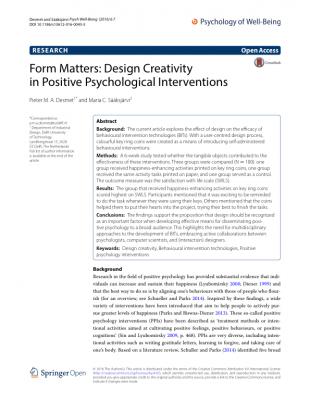The current article explores the effect of design on the efficacy of behavioural intervention technologies (BITs). With a user-centred design process, colourful key ring coins were created as a means of introducing self-administered behavioural interventions.
A 6-week study tested whether the tangible objects contributed to the effectiveness of these interventions. Three groups were compared (N = 100): one group received happiness-enhancing activities printed on key ring coins, one group received the same activity tasks printed on paper, and one group served as a control. The outcome measure was the satisfaction with life scale (SWLS).
The group that received happiness-enhancing activities on key ring coins scored highest on SWLS. Participants mentioned that it was exciting to be reminded to do the task whenever they were using their keys. Others mentioned that the coins helped them to put their hearts into the project, trying their best to finish the tasks.
The findings support the proposition that design should be recognized as an important factor when developing effective means for disseminating positive psychology to a broad audience. This highlights the need for multidisciplinary approaches to the development of BITs, embracing active collaborations between psychologists, computer scientists, and (interaction) designers.
Citation
Desmet, P.M.A., & Sääksjärvi, M.C. (2016). Form Matters: Design Creativity in Positive Psychological Interventions. Psychology of Well-Being, 6:7, DOI 10.1186/s13612-016-0043-5




